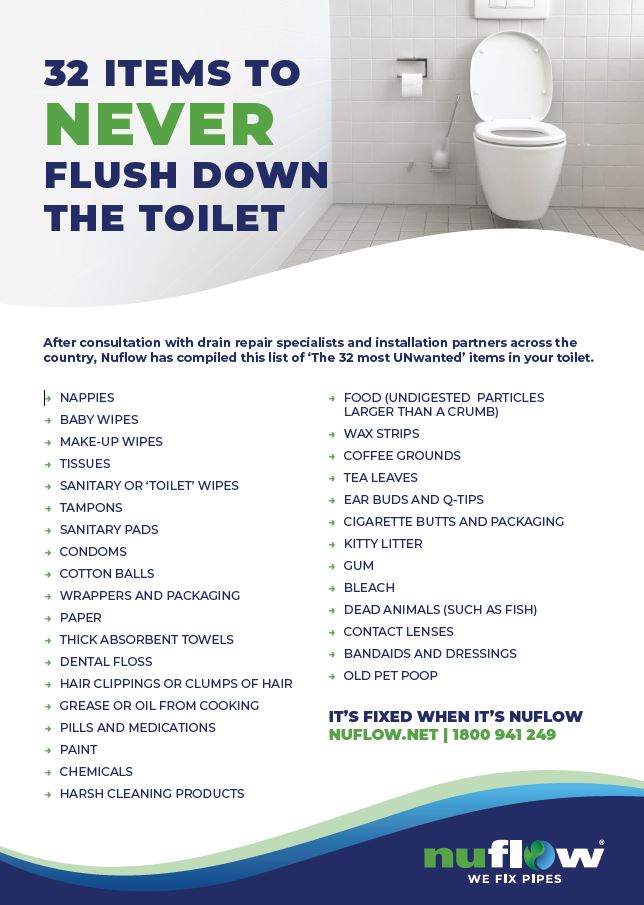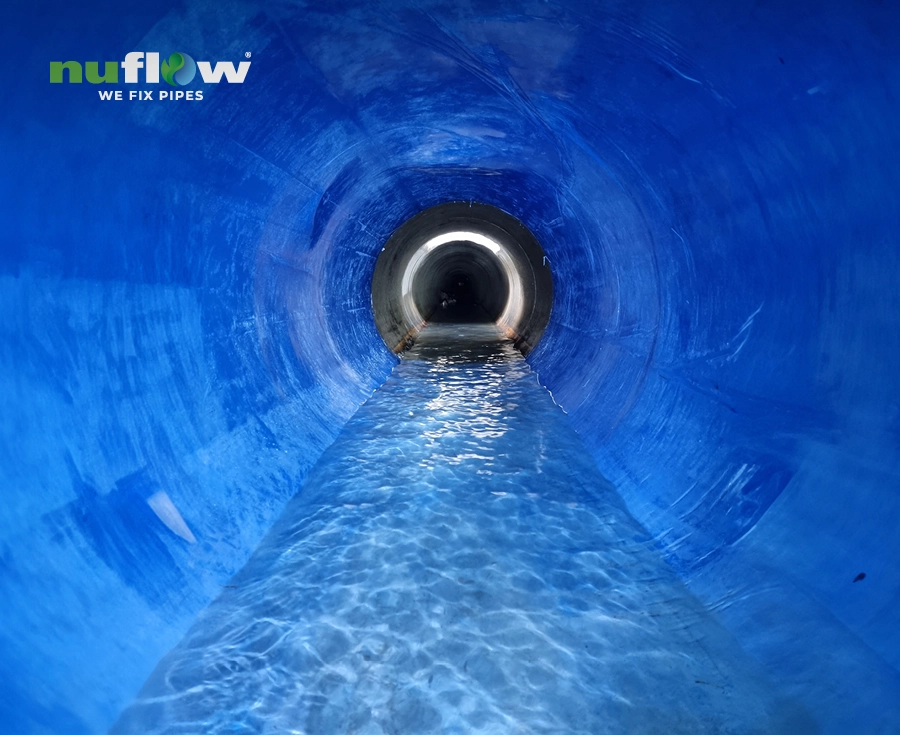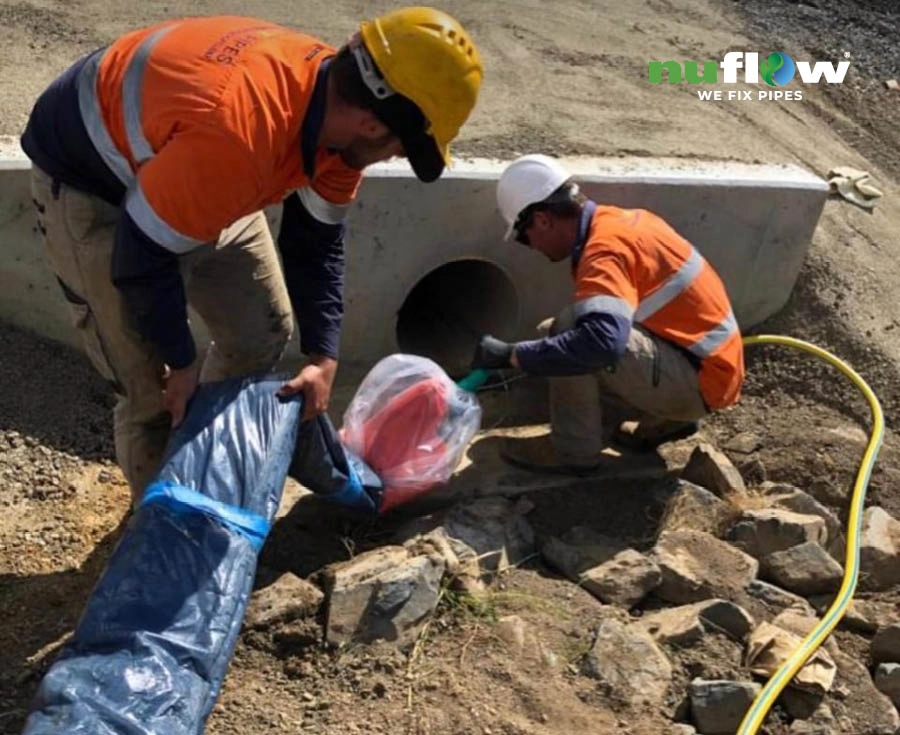Managing what should or shouldn’t go down the toilet in your own home is one thing. But what do you do if you’re responsible for the maintenance of pipes that service public toilets and amenities blocks, or the sewer pipes for a commercial facility? Similarly, if you own an investment property and lease to tenants, or if you manage an apartment complex – whose responsibility is it when sewer pipe blockages occur?
This article looks at some of the difficulties faced by building managers and landlords in terms of managing what enters sewer pipes. It also provides them with tools and guidance about how to educate users about what should not be flushed down toilets and positive ways they can educate users about the importance of maintaining sewer pipe health and changing bad habits.
A list of 32 of the items most commonly found blocking sewer pipes in Australia is also included at the end of the article in a format which can be printed off by building or commercial site managers to be used as signage.
The article also offers some advice for those who want to try to clear such blockages themselves, and things to consider when deciding on who to call when professional sewer pipe clearing or repairs are needed.
Also, see Four (4) things property managers should know about plumbing pipes.
Reducing sewer pipe blockages in public and multi-use amenities blocks
When a whole range of people are using toilets it can become very difficult to police what is and isn’t going down into the abyss. There are cultural differences to account for, ignorance about what can block pipes and bad habits people might have developed over a lifetime and which have previously caused no issues they were aware of.
There is also the fact that sometimes when you’re out in public, disposing of a whole range of things quickly, effortlessly and secretly behind closed doors down that neat, little, watery hole and pressing the flush button can be the easiest way to walk away from a host of embarrassing or inconvenient situations.
Sewer cleaning can increase costs & damage the environment
Whatever it is that brings people to dispose of inappropriate items in toilets, people responsible for keeping pipes in working order in multi-use or public or toilet facilities often face significant problems and hefty repair costs as a result.
The guilty culprits who dispose of whatever they please down the toilet may shrug their shoulders thinking it isn’t their concern, but these unnecessary maintenance and pipe repair costs can run into tens of thousands of dollars and someone has to pay.
- Council-operated toilet block
Then ratepayers will foot the bill to have the pipes cleared, repaired or relined - Hotel, cinema or shopping complex
The costs will be absorbed by way of higher lease or rental fees and eventually higher prices charged to consumers - Apartment block
Then it will be higher body corporate fees
And even if no immediate blockage occurs in the sewer pipes directly servicing that particular facility or building there is a very high chance the inappropriate items will eventually wind up in nearby sewage treatment facilities or in the ocean and cause a range of other significant issues. Waste treatment facilities are funded by public money (taxes and rates) so the more damage caused as a result of careless use of toilets means increases in costs to the public or a reduction in expenditure in other important areas like roads and infrastructure, education or health.
Additionally, non-biodegradable items (including plastics, nappies, wipes etc.) that reach the ocean contribute to land and ocean pollution and are often ingested by marine creatures causing them a painful death.
Use education to reduce sewer pipe blockages
In most cases, sewer pipe blockages and breakdowns occur simply because the wrong things have been disposed of in the toilet. The hard part is that when the toilets you manage are utilised by high numbers and different types of people you can’t rely on the fact that all users are aware of what your pipes can and can’t handle. Nor can you be in there with users making sure they do the right thing. But what you can do is be proactive about educating and guiding people about the behaviour you’d like them to use, and thanking them for (hopefully) doing the right thing.
When people shut the cubicle door voila! nine times out of ten you have a captive audience; every marketer or communicator’s dream. How often have you yourself sat alone in an amenities block toilet and read either the graffiti sprawled across the walls or some dull advertising pamphlet someone has posted behind the door?
Having fewer sewer pipe problems in public or multi-use toilet facilities could (in part at least) be as simple as capturing your audience’s attention with creative signage that informs, entertains and possibly even engages or invests them in the benefits of ensuring nothing harmful enters that toilet.
Creating signage for toilet cubicles in public facilities or apartments
- Make it entertaining and informative
To entertain and inform your captive audience, you can use humour, statistics or quotes from respected authorities such as the World Health Organisation, the Environmental Protection Authority or a highly regarded waste management group. You could also use quotes from environmentally conscious celebrities you know are popular at the time with the public; whatever you think your most frequent users might relate to and enjoy reading. Various strategies might work, so you could consider having a couple of different alternatives and see which works best. Overall it’s still a small investment of time and a bit of laminating that may cost you many thousands of dollars in fixing blocked drains over time. - Tell people what you don’t want placed in the toilet
Your job is to simply let people know what you’d prefer they didn’t flush down your pipes. It’s simply a fact that not everyone knows exactly what can cause trouble, and your sign needs to be worded in such a way as to suggest you are doing people a favour in a way, by explaining what it is that causes trouble. At the end of this article we’ve created a list of 32 of the most common problem-items found blocking sewer pipes. Feel free to copy this list or add/delete items depending on their relevance to your situation. - Tell people what could happen if these things are placed in toilets and sewer pipes
Many people are not terribly well-informed about what happens to their offerings once they hit that little button on the top of cistern. So again, it’s your job to let people know what the consequences of placing inappropriate items in sewer systems can be. You could explain, for example, that blockages can mean toilets are shut down, that there is environmental damage and sewage leakage to surrounding soils, that there is potential damage to marine life as a result of ingesting non-biodegradable wipes, or that high pipe repair costs result in higher end costs for users, tenants and consumers etc. - Use diagrams, symbols and colours
You should also use diagrams where possible so that non-English speaking people can easily understand what is required. In most countries people understand that red is for ‘stop’ or ‘no’ and green is for ‘proceed’ or ‘yes’, and that a cross means no whilst a tick means yes. Again, diagrams can introduce humour and tell a story, all of which can be helpful. - Consider using other languages
If you know you have a lot of users from a particular culture have copies printed in their native language as well. This is more likely to attract their attention and encourage them to comply with your requests. - Thank people for their assistance
Once you’ve explained to your audience what you don’t want disposed of in your toilets and why, you can finish with some sort of thank you for having done the right thing. Most people, once fully informed, will usually do their best to do the right thing so work on that premise and be positive about your belief in them. Making threats or delivering orders will usually not work well, whereas encouragement about the positive contribution they are making on a number of levels can go a long way toward building better relationships.
And on a more globally responsible level, by installing quality signage that identifies what should NOT go down the toilet in commercial and public amenities, not only will you help reduce the costs associated with maintenance and repair of your own facility’s sewer pipes, but you will have a positive impact on the wider community’s general level of understanding of these important issues.
This will most likely help bring about changes in behaviour that will have broader positive benefits for our precious marine creatures and the environment as a whole.
How to fix blocked sewers if they do occur
Of course if all this sound advice is too late and you are already dealing with the issue of a blocked or broken drain, getting it cleared is a priority. If you feel it might be relatively easy to shift, you (or your maintenance team) can try some of these popular do-it-yourself methods first. Always remember to wear gloves and protective gear before trying to clear sewer pipes.
Do it yourself sewer pipe cleaning methods include
- Dishwashing detergent
NOT hand soap pour in about half a cup and let it work its way down the pipe. If the blockage is quite minor this alone may work. - Large bucket of warm water
Up to 10 litres at a time, but not too hot as the porcelain might crack you can also add dishwashing detergent if you feel the added lubrication may help. Low flush toilets help us save water, but are not as useful at keeping sewer pipes clean and clear as the full flush option. If you have a blockage, you need a good, strong current of warm water to flow through the pipe to get things moving. Pour the water with some force, and from a height, quite quickly. You can hit the full flush button at the same time to give it some extra oomph. Ensure you wear gloves and protective equipment and are standing far enough back to avoid splashback. - Plunger
These are readily available from hardware stores and are invaluable when it comes to clearing blockages in drains and toilets. Get one with an extendable handle and as always, wear gloves and protective gear. Push gently on the first plunge but once the suction is generated give around 20-30 vigorous plunges of varied intensity. Always aim to keep the plastic bell covered with water. - Plastic wrap
If you don’t have a plunger, you can create an air-tight seal over your toilet bowl using cling or plastic kitchen wrap. Put double-sided tape at the rim of the bowl and tape the cling wrap over the whole bowl (ensure the seal is airtight and secure). Next, just flush the toilet which should create a lift in the cling wrap. Gently (at first) press the wrap gently down. The extra air pressure should push through the pipe and hopefully clear the blockage. - Vinegar & baking soda
Some people swear this helps shift blockages, but given that the effectiveness of this solution is really dependent on the cleaning power of the gases created as a result of mixing these two substances (rather than the substances themselves) and given the fact that to really clean, these gases need to be in a sealed container (which a sewer pipe is not), there are many others who believe it is more the perception of action that the bubbling broth gives us that people like, rather than any significant impact it has. - Toilet snake
These are readily available at hardware stores however there is also strong opinion that they can damage your pipes. Ensure you’ve had professional advice and guidance if you are attempting to use this tool.
Call the professionals…
Ensure they offer CIPP pipe relining!
If these methods fail and you need to call in an expert, it is very important that you consider what might happen if the cause of your troubles is actually a break, rather than just a simple blockage that can be cleared.
Whilst most sewer cleaning and drain clearing companies will have all the CCTV camera inspection equipment needed to locate the area and cause of the damage, and the hydro jet drain cleaning equipment (or other) to clear things out, they may have limited alternatives to offer in terms of how to repair things if the blockage has caused any actual damage (cracks or breaks) to the pipe itself.
For example not everyone who does drain cleaning in Melbourne is going to employ qualified plumbers and not every sewer cleaner or hydro jet drain cleaning outfit in Brisbane is going to also have easy access to affordable relining technologies and equipment.
If in fact the sewer pipes have broken or collapsed (either as a result of a blockage or simply as a result of earth movement, age or tree root invasion) they are most likely allowing sewage to leak out into the surrounding soil and dirt and tree roots to enter and further block the pipe, so repairs need to be carried out as a matter of urgency.
If the drain cleaner you have contracted is not trained and experienced in non-invasive, cured in place pipe (CIPP) relining, they may be limited in the repair options they can offer once the blockage is cleared. This will mean they (or you) will then need to call a reputable pipe relining company such as Nuflow if you want your pipes repaired without the disruption and expense of excavation.
It is always going to work out much more cost-effectively to call a company that not only uses qualified plumbers to investigate and fix blocked drains and pipes, but that also offers sewer pipe relining in case a break has occurred. This will mean they can offer you the option of either digging-up and replacing the broken pipes (if, for example, the break is in an open, easily accessible area of the property) or relining them with advanced composite resins and CIPP relining (if that pesky leak happens to be beneath a built structure such as a pool, basement car park or slab floor).
Make a list of what you DON’T want flushed
As promised, we’ve done the research and spoken to the experts to come up with a list of the 32 items most commonly found clogging and blocking sewer pipes in Australia.
You may have others to add, or may want to take out some that don’t seem to cause you issues but we are confident that if these items can be prevented from entering your sewer pipes, your toilet troubles will be few and far between.
There are some interesting inclusions which even the editors of this article were unaware were harmful for toilets. Pet poop, for example, is often hardened and can be like small rocks catching in larger blockages. Some people might also be surprised to learn undigested food can cause major problems, and that tissues are actually made differently to toilet paper and should never be flushed.
- Download: 32 Items not to flush down the toilet flyer (PDF)
Feel free to print off this list and use it as the basis of your sign for the back of your toilet doors.





